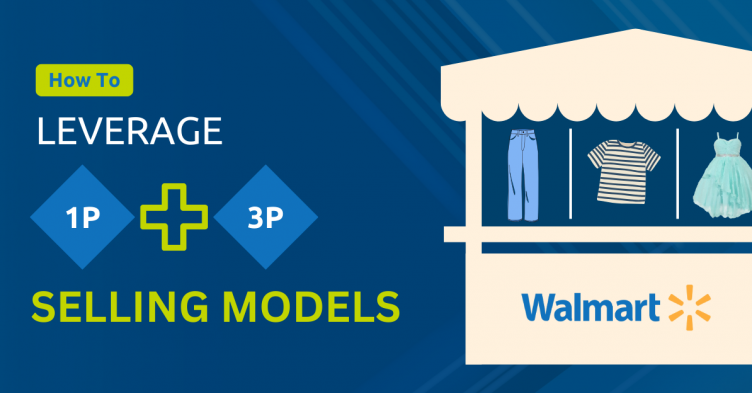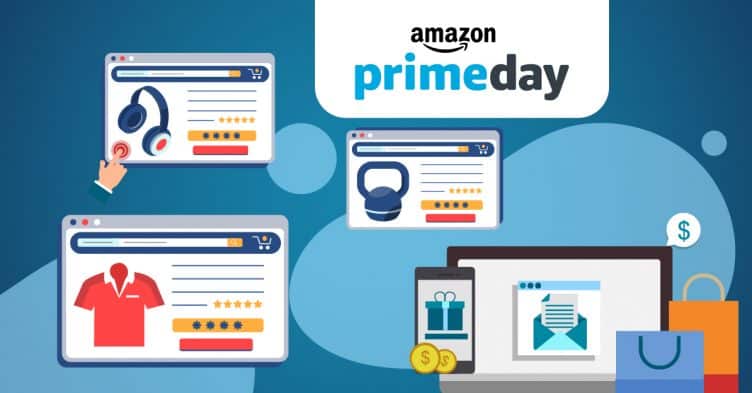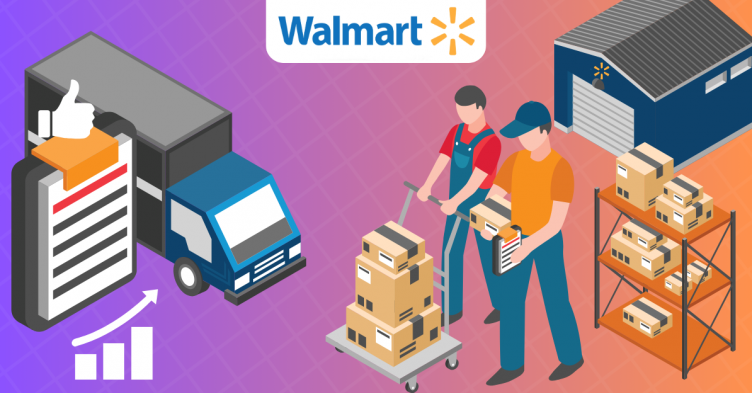What is an eCommerce Shopper’s Journey?
An eCommerce shopper’s journey is a path followed by your shoppers before making any online purchase journey decision via several touchpoints. These touchpoints work together to create an overall shopping experience for your customers that might be positive, negative, or neutral. In simple terms, it is basically a complete experience of a shopper with your online retail brand. As it gives an overview of communication between you and your shopper.
The eCommerce shopper’s journey might last days, weeks, or even months. The average amount of time between a product search and a purchase is 20 days on Google and 26 days on Amazon. According to Amazon, only 4% of shoppers are converted to purchase immediately. And 35% of shoppers on Google are converted within 5 days. When a shopper is looking for a product online and gets interested, they don’t make a purchase decision right away. Instead, they begin researching the product on search platforms like Google and Bing, compare prices on online marketplaces such as Amazon, Walmart, Target, and others, and assure the quality by scanning through reviews and ratings on different online forums before they reach the final decision. The shopper’s online purchase journey from interest to research to consideration to a purchase decision is still prevalent. However, the way people make decisions are getting messier and Google calls this the “messy middle”. This notion indicates that the customer journey is not linear, and there is a lot that happens between the trigger (need/interest) for a product and the actual purchase, more on that later. These touchpoints are then used to continue the eCommerce shopping journey of customers.
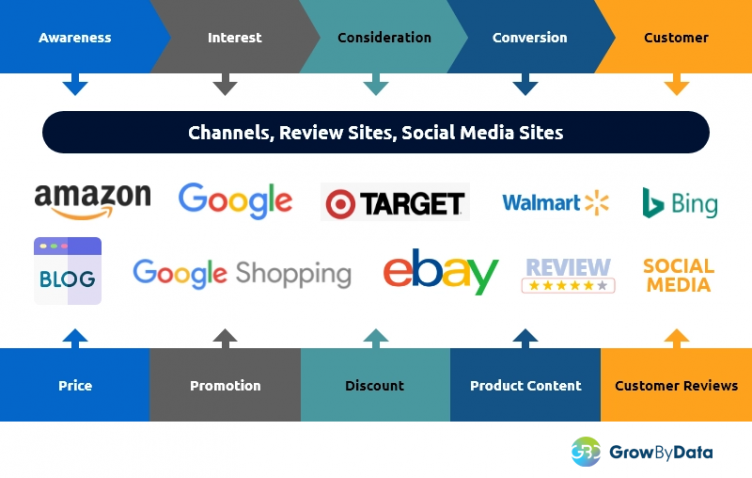
What is the importance of the Shopper Journey Experience in eCommerce?
The online shopper journey experience is an important element of a successful eCommerce business strategy. Your eCommerce website is all your shopper sees and interacts with, as well as forms a view about your online retail brand through it. Thus, your website can either make or break your business. So, analyzing these interactions as a ‘journey’ with separate stages is a useful method to seek the complete picture of a shopper’s experiences and understand what they could be seeking and requiring at different times. Additionally, using advanced marketing intelligence software to understand the shopper experience can be helpful to improve your tactics to cater to your digital shopper.
Awareness/Interest Stage
In the awareness/Interest stage, shoppers are in the get-to-know phase with your brand/product. Potential customers are just realizing a need/want for a product. They are likely to do their research to further understand their need/want to pinpoint a product or solution.
The goal for brands at this stage is to introduce your brand to the digital shopper, inform them of certain products/solutions, and possibly nudge them forward in their journey. That means you should optimize your product feed to increase the search findability of your product, optimize the digital shelf, and optimize the product experience of your brand. At this stage the shopper is making broad searches, so your job is to cast a large net, so increase the chances of catching their attention.
Learn More: Importance of Product Experience for Your Brand
As a brand, you want to target customers that are typically using top-of-the-funnel keywords and phrases. For example, a shopper at the awareness/interest stage of buying running shoes may use broad keywords like ‘running shoes’, ‘comfortable running shoes’, ‘wide running shoes’, etc.
The average amount of time between a product search and a purchase is 20 days on Google and 26 days on Amazon.
Typically, as a brand you want to highlight your products via blog posts, articles, videos, social media posts, educational content, infographics, FAQ pages, etc. as the digital shopper is trying to learn about the products/solutions to fulfill their necessity. Therefore brands and retailers must perform complete competitive SERP analysis to understand what type of content is showing up on specific keywords and where your brand is not showing up. Understanding these things allows brands to strategically create content for each keyword and product to increase their share of voice across the SERP for each keyword and product.
Consideration Stage
The shopper has done their research and is now considering their options. They are comparing prices, evaluating your brand versus the competition, and assessing the credibility of the products by looking at reviews and ratings to minimize their options and move closer to a purchase decision.
Creating optimized ad content and landing pages using relevant keywords is crucial. The right keywords need to be placed in the titles, good reviews and ratings need to be highlighted, and extensions & labels need to be properly utilized.
Shoppers at this stage typically will be using middle-of-the-funnel keywords and phrases. Following the example of the shoe shopper above, at this stage, they may use keywords like ‘best-running shoes for men’, ‘comfortable trail running shoes’, ‘best women’s running shoes under $100’, etc. And shoppers will not only search on one channel but will perform the search across multiple channels.
As a brand or retailer, you need to do market research and perform market analytics for your targeted keywords and products to understand what kind of ads and products are showing up, what kind of ads/products your competitors are advertising, and what kind of extensions, annotations, & labels are being used across marketplaces and the shopper journey.
Conversion/Decision Stage
This is the stage where the shopper chooses to purchase a product or service. This might be the most critical stage for any seller as the sale is won or lost at this stage. But if your product shopping experience is optimized for the previous stages of the eCommerce shopper’s journey, then you have put your brand in strong contention to win the sale. These days it is extremely difficult, almost not possible to win a sale by just showing up at the decision stage of the digital shopper.
According to Amazon, only 4% of shoppers are converted to purchase immediately.
Shoppers at this stage will most likely be using bottom-of-the-funnel keywords and phrases. Following the example from above on our running shoes shopper, at this stage, they have a much better sense of what they want which prompts searches like ‘black Asics men’s running shoes’ or ‘Saucony trail running shoes 10’, etc.
This is the stage to show why a shopper should choose your products over the competition. So, features like price, reviews, discounts, promotions, special offers, etc. need to be highlighted at this stage to sway the shopper towards your brand.
Price may be the most important feature that could have the biggest influence when it comes to a purchase decision. Having competitive prices for a product is extremely crucial as it can make or break the sale. A tool like Price Intelligence can help brands and retailers monitor competitor prices across multiple marketplaces and provide dynamic pricing strategies for efficient price optimization.
Retention, Referral, and Cross-Selling Stage
Winning the sale is great, but now you need to think about retaining the shopper for the long-term success of your business. So, the next focus is on retention, referrals, and cross-selling.
Gaining a new customer is always much harder than retaining an existing customer. Some of the ways to stay in the mind of the shopper are to notify them of upcoming promotions, special offers, discounts, new products launch, product updates, news & events of the business, etc. It is about providing shoppers a value that your competition may not be providing.
35% of shoppers on Google are converted within 5 days.
Another important step at this stage is cross-selling to your customers. For instance, if you are a crocs seller then you can offer a product like Jibbitz to that shopper. This cross-selling technique will help you win more sales.
How does marketing intelligence help to address the complex eCommerce shopper’s journey?
“Customers are kings” they design their own purchase journey; they move from one touchpoint to next as per their want to fulfill their needs. The role of brands/retailers/advertisers is to anticipate these needs and create an omnichannel environment that facilitates their online shopping journey. To accomplish this, brands/retailers need to utilize powerful online marketing intelligence tools that can provide unified insights across the shopper journey that allows for deeper views into shopper attributes throughout the shopper’s journey that can help provide insights into the buying behavior across the digital shelf. Marketing intelligence is vital for success and to gain a competitive edge.
GrowByData Marketing intelligence empowers brands and retailers with 360-degree insights to drive eCommerce performance, providing them the necessary granularity and deeper visibility required to optimize the digital shelf across the shopper journey.
Thus, using such a powerful tool, you can gain key insights into your competitive landscape, get visibility into your digital shelf performance, and develop a better understanding of your consumer behavior so that you can identify the critical market trends/demands to capitalize on the unmet customer needs and fill in the gaps in the market.
1. Digital Shelf Visibility Across channels or marketplaces
Our Marketplace intelligence tool provides you with unified visibility across the marketplaces like Google, Amazon, Walmart, Target, Best Buy, and others. It allows you to optimize the channel performance across the entire shopper journey. Not only that, but you will also be able to hyper-target your shopper data down to zip code along with holistic visibility across ad types/formats – text ads, image ads, shopping ads, display ads, organic ads, sponsored ads, etc.
This tool provides you with holistic insights into multiple channels and competition at every touchpoint of the shopper. The insights include visibility into reviews, ratings, rankings, competitive pricing intelligence, etc. across channels giving you a comprehensive picture of your industry landscape and market potential. Graph 1 below shows the visibility of Reebok on each of the channels and graph 2 shows the visibility of reviews, shipping, sales, and promotions across the channels. Our tool has the capabilities to dive deeper into the attributes and brands on a keyword level as well which gives you insights into your brand’s performance at each stage of the shopper journey.
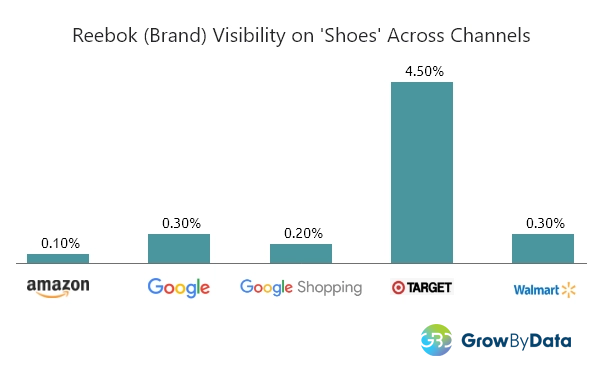

2. Optimize your digital shelf across the Shopper Journey
Digital shelf optimization is the process of continuously optimizing your presence on the digital shelf across channels and the shopper journey. It is very important because it determines whether your product can be found or not during a digital shopper’s purchase journey.
Brands and retailers have limited data in terms of granular visibility into the performance data. They do not have a holistic view of the shopper’s journey to optimize the digital shelf without a single source of truth.
With the help of search intelligence, you can increase the findability of your products within your digital shopper’s journey. It allows you to do end-to-end competitive (SERP) analysis to gain deep visibility across all SERP features – text, ads, display ads, shopping ads, and organic traffic. In addition to that, it also gives you an unprecedented near real-time view into increasing the search findability with strong SERP share-of-voice, competitive opportunities, and monitoring the price competition all in one place.
We examined the Google Shopping Organic Shelf with marketing intelligence software for 100 ‘Shoes’ related keywords targeting different stages of the shopper journey. When we look closer into the data on how various shopper attributes like variants (color, material, size), demography, etc. play a role in the listings, we found that the listings that fall in the conversion phase have a higher usage of variants, demography, and product purpose/genre (running, walking, work, dress, etc.) as shown on the graph. The use of google shopping ad extensions and labels like ratings & reviews were more prevalent in the consideration and conversion of keyword listings as well.

3. Optimizing the messy middle to gain an edge
As we’ve mentioned above, the shopper journey is not straightforward. There’s a lot that happens in between when a shopper moves from one touchpoint to the next to reach a final decision. As a result, focusing on and optimizing for a single SERP characteristic is no longer sufficient. You must extend your efforts across the whole customer journey as an eCommerce brand. This might entail signing up for review sites, aggregator sites, content syndication sites, and other similar services. To gain market share in the “messy middle,” creating and optimizing several contents that fulfill a shopper’s informational demands at various stages of the online purchase journey is crucial.
As we talk about earlier in the article, shoppers at different stages are looking for different content and information. Therefore, as a brand, it is imperative to not just try to get your website into the SERP, but it is vital to have contents that are optimized to show up on review sites and other retail sites as well, so that the number of times your product/brand is seen by the shopper increases, thus increasing your brand visibility.
4. Competitive Product Experience Management
With the expansion of digital technology, today’s shoppers expect a user-friendly digital shelf that is convenient, personalized, and with an optimized product detail page. Product Experience Management (PXM) is the process that eCommerce businesses use to provide the right information at the right place at the right time to increase sales, market share, and customer loyalty. A comprehensive product feed tool in conjunction with pricing intelligence software and product intelligence tools will help your eCommerce business enhance the product experience of your brand.
These tools will help you improve the buying ability and availability of your product/brand across the shopper journey. They provide insight and awareness into the characteristics that distinguish your brand’s product from the competition and attract shoppers to choose your brand’s product over the competition. It enables you to identify content gaps and take advantage of new trends to increase the chances of engaging potential customers with your brand.
These Search Marketing Intelligence tools also offer granular data and insight into:
- Shipping Intelligence: What kind of shipping labels are your competitors using? What is the trending shipping label? What percentage of ads have shipping labels at each stage of the shopper journey?
- Promotions: What are the trending promotions in the market? What promotion is popular among your competitors?
- Reviews and Ratings: What kind of reviews and ratings do your competitors have? How many reviews and ratings do the top ads have across the channels and shopper journey?
It’s imperative to proactively examine ad extensions by industry and keywords, rather than reactively analyzing and experimenting on winning combinations. A continuous supply of granular data and insight across channels and the shopper journey from Marketing Intelligence tools allows brands and retailers to make the right decisions to maximize their visibility, conversion, and sales revenue.
Final Notes
One cannot underestimate the importance of maximizing a brand’s touchpoints with a digital shopper. For brands/retailers, using a powerful marketing intelligence tool with search intelligence, marketplace intelligence, product intelligence, and product feeds will help you better align your digital shelf to the shopper journey.
If you want to have a successful eCommerce business, providing an excellent customer experience along with a simplified online purchase journey should be at the top of your priority list. The idea is to assess your defined approach at each touchpoint and come up with new approaches to enhance them as you go.

